An Inca Delicacy for Times of Rain
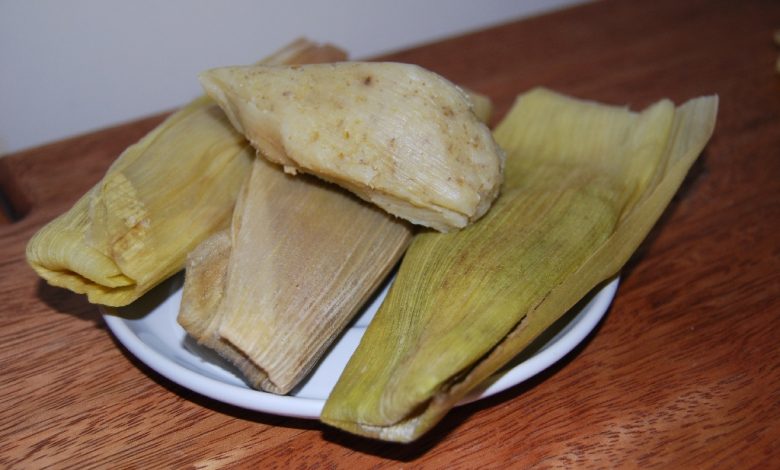
What is yellow and white, folded over, ancient and modern? An huminta, of course, one of the amazing delicacies of the Andes. And, this is the time of the year to enjoy it.
Inca Garcilaso de la Vega, the grandson of the Inca and Spanish gentleman felt so frustrated with so many things said about Peru and the Incas that in the late sixteenth and early seventeenth century he wrote his memoirs about what life was like in the Cuzco where he grew up the son of a Spanish conqueror and an Inca of noble family. In them he mentioned humintas.
I was brought up on sara or maize, the bread of which is known by three names — sancu, bread for sacrifices; huminta, special bread for celebrations; and t’anta(the first syllable pronounced in the palate), common bread.
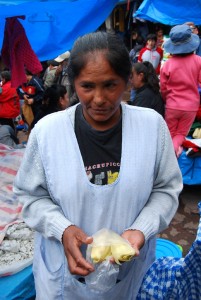
Earlier Garcilaso had written:
For their solemn sacrifices [the Incas] used, as we have mentioned, a maize loaf called sancu and they made the same bread to eat as an occasional delicacy; they called it huminta. The two names were applied not because the bread was any different, but because one kind was used for sacrifices and the other simply for eating. The flour was ground by the women on broad flat stones. They laid the grain on one of these and applied to it another stone, shaped like a rather elongated half moon, though not rounded. It would be about three fingers broad, and the women held it by the two points of the half moon and moved it to and fro on the maize. In this clumsy way they ground their corn . . . because of the difficulty of the process they did not eat bread regularly.

Amazingly, so many of the foods and ways of cooking Garcilaso describes continue to be found in modern Cuzco. Sancu may have disappeared along with much of Inca high religion, but humintas still remain, as does the word t’anta which is now applied to wheat bread, and most kitchens still have the grinding stone Garcilaso describes which is called a batán. (In the quote from garcilaso I modernized the spelling of Quechua words. DK)
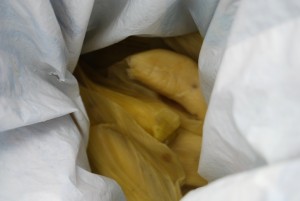
The Spanish brought to Peru a different word for Garcilaso’s bread, tamale. Of Nahuatl origin and borrowed from the Aztecs, this word came to mean in Peru the “bread” made from ground dried corn, folded in corn husks, and steamed. The word huminta, oftentimes Hispanized as humita, continued to mean things like tamales but made from fresh corn–what in English we often call “sweet corn,” though Cusco’s corn with its stark white kernels is not as sweet as the American.
As a result it balances well with other ingredients. Sometimes it can be made sweet and sometimes salty, without the natural sugars in the corn overwhelming the preparation.
This is the season for humintas, when the rain falls and corn swells its husks. Markets fill with ears of fresh picked corn on the cob and humintas begin to appear. If you only know tamales, you are in for a surprise when you try humintas. They have an unexpected and pleasing softness and delicacy.
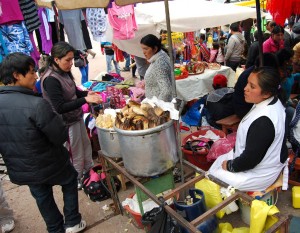
Although humintas are characteristically Cuzqueño, they are also found in the other countries that once formed part of Tawantinsuyo, the Inca Empire. However in every place they are different, involving slight differences in preparation and in other ingredients, besides corn, that are added to them.
In what follows we provide a simple recipe for humintas. Not only can you enjoy them in Cuzco, you can try them at home. You should adjust the amount of sugar according to the sweetness of your corn and to your taste. Remember, though wonderful, Cuzco’s corn is not as overwhelming sweet as North American sweet corn.
Humintas
Ingredients:
- Ten fresh ears of corn
- 1/4 Kilo sugar to taste
- Aniseed to taste
- Cinnamon stick to taste
- 5 gms. baking powder or baking soda
- Lard
- 5 eggs
To make humintas we require corn that is not fresh picked but maybe a day or two old. It is good to cut the husk from the corn in such a way that it can be used later as a container for the corn dough. Remove the kernels from the cob (if using Andean corn , or corn with a tough outer coating, your shell each kernel one by one) the grind the corn in a food processor or food grinder.
In a cup of water boil aniseed, a stick of cinnamon, and the sugar with which to flavor the humintas.
In a bowl mix the ground corn with lard ( sufficient to get the right texture–not too much nor too little) , the flavored, hot water, baking powder or baking soda (in a quantity that adds your preferred degree of lift to the dough), and five eggs until it firms a stiff dough.
Let it rest for some thirty minutes.
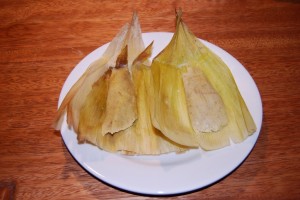
Choose cleaned corn husks and add a tablespoon-full of the mixture to one, fold and tie with threads made from the corn husks.
Add the prepared humintas to the upper part of a steamer and steam until firm to the touch.
Serve warm.




